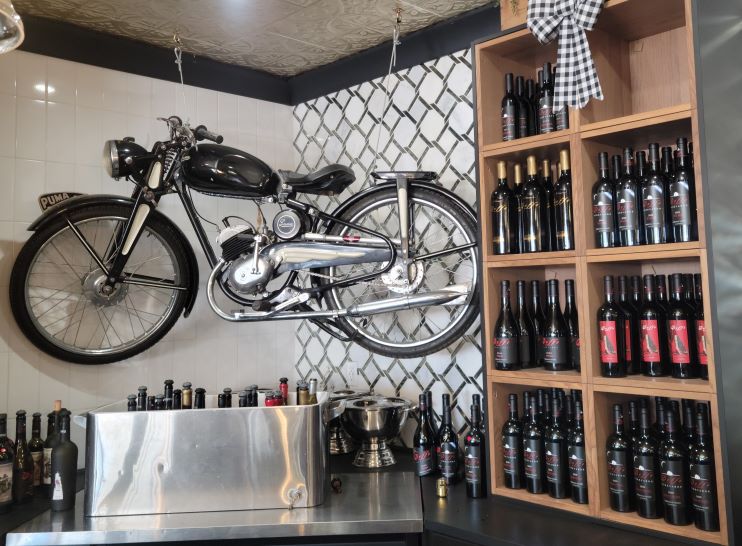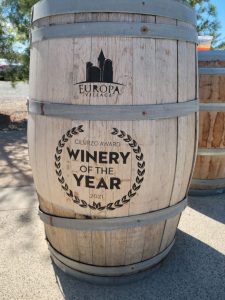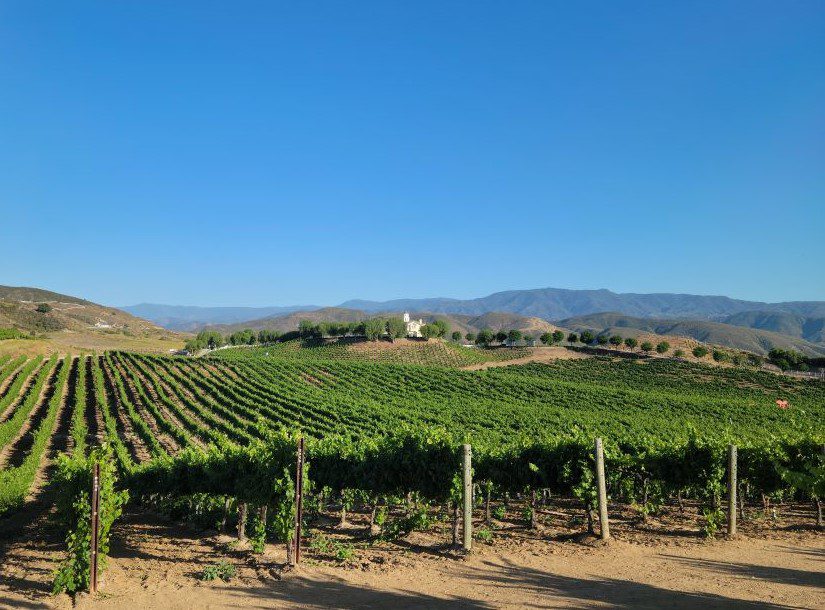Next time you’ve got an extra couple of days in Los Angeles or San Diego, Becky Sue Epstein recommends a visit to the Southern California wine region, which she recently visited after a long absence and found the wines are a changing for the good.
If wine grapes have been grown in California’s Temecula Valley since the 1820s, why are we only hearing about it now? And what are the wines like? That’s what I recently went there to find out – having not visited for several decades, since I lived in Los Angeles.
Temecula is located in the southern part of California, between Los Angeles and San Diego, about 20 miles inland. Currently, it’s a significant resort area for weekenders and day-trippers from both cities. Twenty-three million people live within an hour or two’s drive of Temecula.
Tourism is such a strong element of the Temecula economy that local wineries sell virtually all their wines direct to consumers at tasting rooms and through wine clubs. Since it’s nearly impossible to buy Temecula wines outside of the region, you might assume that the wines here might not be of great quality. In fact, this has been partially true in the past. But based on what I recently sampled, things are changing.
First, some necessary background about the weather, history and terrain of this little-known California wine region.
Climate
Though the Temecula climate is termed ‘Mediterranean’, it feels quite desert-like when you’re there – dry, with major temperature inversions between day and night, as in the rest of inland California. However, the climate in Temecula is tempered by cool Pacific Ocean breezes that blow in through a few gaps in the coastal hills every afternoon. Chilling down the grapes allows them to ripen more slowly, and the significant diurnal temperature variation delivers wines with more aromatics and complexity. Planted on the low hillsides of this region, the vineyards are mainly at 1,000 to 1,500 feet (300 to 450 meters).
History
Two hundred years ago, Spanish missionaries were the first to figure out the advantages of Temecula’s climate when they needed to grow grapes to make wine for ceremonial use. In the intervening time, California became part of the United States (1850), the Spanish missions disbanded, and their vineyards gradually vanished in this sparsely-populated area.
Prohibition basically shut down US winemaking in 1920. When prohibition ended in 1933, most new Southern California settlers chose the more commercial areas around Los Angeles. Agriculture burgeoned everywhere but vineyards were relatively rare in the mid-20th century.
Of course, there was an emerging wine industry in Northern California in the late 1800s. But remember, the distance between Los Angeles and San Francisco is 400 miles, roughly the same as from London to Edinburgh, but at that time it was a journey of many days, through mainly non-settled lands. Taking this into account, it’s not surprising that the two Californian areas developed independently, both economically and culturally.
By the late 1960s, a few farmers were planting grapes in the Temecula area again. Wineries followed; the first was Callaway Vineyard and Winery, established in 1974 by Ely Callaway, who went on to found the legendary golf equipment company that bears his surname. At my first Callaway tasting years later, I was extremely impressed with a Chardonnay-based dessert wine that I remember to this day. Perhaps the early production of sweet wines led to the region’s development more as a tourism destination than a serious wine region — though by now, sweet wine production is much rarer in Temecula.
Callaway itself has since undergone several ownership changes, while remaining a leader in hospitality with its tasting room, Meritage restaurant, and meeting and wedding venues. This winery seems to have set the scene for the weekend-fun style of tourism that began to blossom there with many additional wineries appearing toward the late 20th century, and continuing into the present.
In terms of wine, the Temecula AVA was established in 1984. It was amended to Temecula Valley AVA in 2004. The area has strict geographical delimitations, and irrigation is allowed. For perspective, the city of Temecula was incorporated as recently as 1989, and the 2020 census listed its population as 110,000.
Today

At present there are about 50 wineries in Temecula, with more in line for permitting, along with many additional hotels, inns, and bed-and-breakfasts. Most of the wineries I visited last summer offer wedding venues and restaurants, in addition to tasting rooms with a variety of wine tasting and food pairing options; they also host seasonal, monthly or even weekly events – made possible by the mild Southern California winters.
With all this enthusiastic tourist activity – and commensurate wine sales – once again, I was wondering what inspired the winemakers of today to improve their wines. An obvious answer is commercial: to produce more as well as higher priced wines. And perhaps this is where it started. But the winemakers and winemaking consultants I talked with seemed genuinely interested in taking both their vineyards and vinification quality to the next level.
The past few decades have yielded a major increase in research into vineyards around the world. Temecula’s growers and winemakers are now in a position to take advantage of this depth of knowledge. Growers in this region are also conducting their own experiments with dry farming, well-water irrigation, and other sustainable initiatives.
Organic growing has been challenging with the prevalence of Pierce’s disease, and many local vineyards have been replanted since the original problem was identified in California in the 1990s. According to Greg Pennyroyal, a professor of viticulture who is also Wilson Creek’s vineyard manager, great progress is now being made in eradicating the carrier of this disease, finally without harmful chemical intervention.
Having not visited Temecula for some time, I did come away from my visit this time with the feeling that Temecula wines are still a work in progress…but going in the right direction.

The wines
The Temecula Valley Wine Growers organization is the first to admit that so far, no signature grape variety has emerged in this region. In that way, it’s still the Wild West, with growers and vintners trialing and producing wines with grapes that are native to many areas of the world.
In general, the wines I sampled appear to have been made with good intent and care, utilizing the best products and practices available to the winemaker. Not all the wines were stellar; notably with some of the Syrahs and Syrah-based blends it was difficult for me to comprehend what the winemaker was trying to achieve.
There were some positive surprises. For example, this region is one of the few where I liked the Viognier and Viognier-based blends: I found them to be appropriately well-defined and well-crafted. Here are reviews of half a dozen of the best wines I sampled.
2022 Leoness Cellars Melange de Blanc is a Viognier-based wine blended with Roussanne and Grenache Blanc. Very balanced and not too rich. Owner Rebaux Steyn is originally from South Africa. The winemaker is Tim Kramer; he tends to change the percentages in the blend slightly every year.
2021 Leoness Cellars Viognier is made with grapes grown in two separate vineyards, as well as 15% Roussanne and 5% Grenache Blanc. The result is a wine with light fruit, exceptionally lovely minerality and a very long finish.
2016 Carter Estate Brut. Carter Estate, a location where grapes have been grown since 1985, is the largest producer of sparkling wine in the area. The wines are under the South Coast AVA label (Temecula Valley is embedded in the South Coast). The winery produces sparkling wines with Chardonnay, Pinot Noir and Pinot Gris. This wine is 47% Chardonnay and 53% Pinot Noir. It is en tirage for over six years, and this bottle was disgorged about three months before I tasted it. The wine has traditional aromas of citrus, agar, and yeast, which carried through to the palate: a classic profile for a northern French sparkling wine from Champagne or Alsace.
Though the wine is made according to the Méthode Traditionelle, the label says Méthode Champenoise because this region is not a signatory to an agreement with the Champagne region of France – and because the word ‘Champenoise’ is a selling point.
Wiens Family Cellars 2020 Reserve Petite Sirah. This wine was bottled but not yet released, and was slated for their wine club and tasting room, with only 400 cases made. After ageing in French oak (30% new) for two years, the wine has big fruit aromas and flavors, and tannins that are mouth-stickingly-strong. In the tasting room, it will be paired with meats and cheeses. It’s clear this wine will age, and I hope some of the purchasers do lay it down for a number of years. This winery was acquired by the Steinhafel family last year, with the intent to continue their emphasis on estate grown wines.
2019 Doffo Winery Mistura. Produced since 2002, when the winery was just getting started, the first vintage of this red wine was literally a field blend of 60% Cab Sauvignon, 35% Syrah along with 5% Petit Verdot and Cabernet Franc. It has become one of the favorites at Doffo, and I simply enjoyed every sip of this big red wine with tons of fruit: 60% Cabernet Sauvignon and 40% Syrah for this vintage of Mistura. The wine is evolving beautifully, with well-integrated tannins and minerality. (And to think most people may visit this winery mainly for the – admittedly stellar – motorcycle collection.)
2020 Peltzer Family Cellars Feelin’ Cocky. The Peltzers moved to Temecula in 2016 and started a pumpkin farm. Now they have a vineyard, a winery, and a strong wedding business on their adorably rustic-chic estate. This wine carries a California (not Temecula) label; it is blended every year with reds such as Petite Sirah, Cabernet Sauvignon and Zinfandel. Apologies for not being able to report exactly what’s in the wine, it just seemed to pair well with every course in the barbeque-style dinner I was eating.

